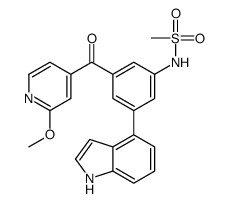| Description |
LP-261 is a potent and orally active anti-mitotic agent and shows an inhibition of in vitro tubulin polymerization with an EC50 of 3.2 μM[1]. LP-261 inhibits growth of a human non-small-cell lung tumor (NCI-H522) in vivo and can be used for cancer research[1].
|
| Related Catalog |
|
| Target |
EC50: 3.2 μM (tubulin polymerization)[1]
|
| In Vitro |
LP-261 shows potent G2/M block activity in multiple cell lines and exhibits a range of activity from 0.01μM to 0.38 μM across the tested cell lines, the IC50 values for MCF-7, H522, Jurkat, SW-620, BXPC-3, and PC-3 values are 0.01 μM, 0.01 μM, 0.02 μM, 0.05 μM, 0.05μM and 0.07 μM, respectively[1]. LP-261 exhibits low micromolar potency in the tubulin polymerization assay, the EC50 value of LP-261 is 5.0 μM[1]. LP-261 has the ability to compete with colchicine for binding to tubulin in a [3H]colchicine competition binding assay, the EC50 (3.2 μM) for LP-261 to inhibit the binding with a potency similar to that of colchicine itself, and it exhibits a 79% inhibition at a conctration of 30 μM[1].
|
| In Vivo |
LP-261 (oral gavage; 4 mg/kg; single dose) displays rapid adsorption by the oral route (Tmax=2.0 h), the terminal half-life of 1.4 h ( 0.2 h indicated a moderate rate of elimination in rat, and the volume of distribution (Vss) is 1.25 L/kg[1]. LP-261 (oral gavage; 15 or 50 mg/kg; twice daily; 28 days) at 50mg/kg results in an approximately tumor volume of 130 mm3 versus 3769 mm3 in the vehicle treated group, this represents a 96% reduction in mean tumor volume. Meanwhile, LP-261 at 15 mg/kg leads to a 41% inhibition after 28 days in this mouse model[1]. Animal Model: Human tumor xenograft model (Injected with NCI-H522 human non-small-cell) in NCr-nu mice[1] Dosage: 15 or 50 mg/kg Administration: Oral gavage; 15 or 50 mg/kg; twice daily; 28 days Result: Had potent anti-tumor efficacy at high dosage and exhibited no significant changes in body weights.
|
| References |
[1]. Rupa S Shetty, et al. Synthesis and pharmacological evaluation of N-(3-(1H-indol-4-yl)-5-(2-methoxyisonicotinoyl)phenyl)methanesulfonamide (LP-261), a potent antimitotic agent. J Med Chem. 2011 Jan 13;54(1):179-200
|
